Applications, Surface Modification and Functionalization of Nickel Nanorods
Abstract
:1. Introduction
2. Nickel Nanorod Applications
2.1. Rheological Fluid Properties
2.2. Data Storage, Electronics, Catalysis and Optical Phenomena
2.3. Sensing and Biosensing Applications
2.4. Cell Biology Applications
3. Nickel Nanorod Surface Chemistry Modification
3.1. Small Molecules Based on Carboxylic Acid Groups
3.2. Small Molecules Based on Silane Groups
3.3. Surface Modification by Polymers
3.4. Surface Modification by Histidine
3.5. Metal or Metal-Oxide Shell Growth
4. Conclusions and Outlook
Acknowledgments
Conflicts of Interest
References
- Odobel, F.; Le Pleux, L.; Pellegrin, Y.; Blart, E. New photovoltaic devices based on the sensitization of p-type semiconductors: Challenges and opportunities. Acc. Chem. Res. 2010, 43, 1063–1071. [Google Scholar] [CrossRef] [PubMed]
- Granqvist, C.G. Electrochromics for smart windows. Oxide-based thin films and devices. Thin Solid Films 2014, 564, 1–38. [Google Scholar] [CrossRef]
- Morozov, Y.G.; Belousova, O.V.; Kuznetsov, M.V. Preparation of nickel nanoparticles for catalytic applications. Inorg. Mater. 2011, 47, 36–40. [Google Scholar] [CrossRef]
- Zhuang, Z.; Giles, S.A.; Zheng, J.; Jenness, G.R.; Caratzoulas, S.; Vlachos, D.G.; Yan, Y. Nickel supported on nitrogen-doped carbon nanotubes as hydrogen oxidation reaction catalyst in alkaline electrolyte. Nat. Commun. 2016, 7, 10141. [Google Scholar] [CrossRef] [PubMed]
- Verrelli, E.; Tsoukalas, D.; Giannakopoulos, K.; Kouvatsos, D.; Normand, P.; Ioannou, D.E. Nickel nanoparticle deposition at room temperature for memory applications. Microelectron. Eng. 2007, 84, 1994–1997. [Google Scholar] [CrossRef]
- Kudr, J.; Haddad, Y.; Richtera, L.; Heger, Z.; Cernak, M.; Adam, V.; Zitka, O. Magnetic Nanoparticles: From Design and Synthesis to Real World Applications. Nanomaterials 2017, 7, 243. [Google Scholar] [CrossRef] [PubMed]
- Schrittwieser, S.; Pelaz, B.; Parak, W.; Lentijo-Mozo, S.; Soulantica, K.; Dieckhoff, J.; Ludwig, F.; Guenther, A.; Tschöpe, A.; Schotter, J. Homogeneous Biosensing Based on Magnetic Particle Labels. Sensors 2016, 16, 828. [Google Scholar] [CrossRef] [PubMed]
- Xu, S.; Habib, A.H.; Pickel, A.D.; McHenry, M.E. Magnetic nanoparticle-based solder composites for electronic packaging applications. Prog. Mater. Sci. 2015, 67, 95–160. [Google Scholar] [CrossRef]
- Gómez-Pastora, J.; Dominguez, S.; Bringas, E.; Rivero, M.J.; Ortiz, I.; Dionysiou, D.D. Review and perspectives on the use of magnetic nanophotocatalysts (MNPCs) in water treatment. Chem. Eng. J. 2017, 310, 407–427. [Google Scholar] [CrossRef]
- Reddy, L.H.; Arias, J.L.; Nicolas, J.; Couvreur, P. Magnetic nanoparticles: Design and characterization, toxicity and biocompatibility, pharmaceutical and biomedical applications. Chem. Rev. 2012, 112, 5818–5878. [Google Scholar] [CrossRef] [PubMed]
- Murphy, C.J.; Sau, T.K.; Gole, A.M.; Orendorff, C.J.; Gao, J.; Gou, L.; Hunyadi, S.E.; Li, T. Anisotropic metal nanoparticles: Synthesis, assembly, and optical applications. J. Phys. Chem. B 2005, 109, 13857–13870. [Google Scholar] [CrossRef] [PubMed]
- Koltypin, Y.; Fernandez, A.; Rojas, T.C.; Campora, J.; Palma, P.; Prozorov, R.; Gedanken, A. Encapsulation of Nickel Nanoparticles in Carbon Obtained by the Sonochemical Decomposition of Ni(C8H12)2. Chem. Mater. 1999, 11, 1331–1335. [Google Scholar] [CrossRef]
- Ely, T.O.; Amiens, C.; Chaudret, B.; Snoeck, E.; Verelst, M.; Respaud, M.; Broto, J.-M. Synthesis of Nickel Nanoparticles. Influence of Aggregation Induced by Modification of Poly(vinylpyrrolidone) Chain Length on Their Magnetic Properties. Chem. Mater. 1999, 11, 526–529. [Google Scholar] [CrossRef]
- Amiens, C.; Chaudret, B.; Ciuculescu-Pradines, D.; Collière, V.; Fajerwerg, K.; Fau, P.; Kahn, M.; Maisonnat, A.; Soulantica, K.; Philippot, K. Organometallic approach for the synthesis of nanostructures. New J. Chem. 2013, 37, 3374–3401. [Google Scholar] [CrossRef]
- Dumestre, F.; Chaudret, B.; Amiens, C.; Respaud, M.; Fejes, P.; Renaud, P.; Zurcher, P. Unprecedented crystalline super-lattices of monodisperse cobalt nanorods. Angew. Chem. Int. Ed. 2003, 42, 5213–5216. [Google Scholar] [CrossRef] [PubMed]
- Wetz, F.; Soulantica, K.; Respaud, M.; Falqui, A.; Chaudret, B. Synthesis and magnetic properties of Co nanorod superlattices. Mater. Sci. Eng. C 2007, 27, 1162–1166. [Google Scholar] [CrossRef]
- Cordente, N.; Respaud, M.; Senocq, F.; Casanove, M.-J.; Amiens, C.; Chaudret, B. Synthesis and Magnetic Properties of Nickel Nanorods. Nano Lett. 2001, 1, 565–568. [Google Scholar] [CrossRef]
- Soulantica, K.; Wetz, F.; Maynadié, J.; Falqui, A.; Tan, R.P.; Blon, T.; Chaudret, B.; Respaud, M. Magnetism of single-crystalline Co nanorods. Appl. Phys. Lett. 2009, 95, 152504. [Google Scholar] [CrossRef]
- Lentijo-Mozo, S.; Tan, R.P.; Garcia-Marcelot, C.; Altantzis, T.; Fazzini, P.-F.; Hungria, T.; Cormary, B.; Gallagher, J.R.; Miller, J.T.; Martinez, H.; et al. Air- and water-resistant noble metal coated ferromagnetic cobalt nanorods. ACS Nano 2015, 9, 2792–2804. [Google Scholar] [CrossRef] [PubMed]
- Toneguzzo, P.; Viau, G.; Acher, O.; Fiévet-Vincent, F.; Fiévet, F. Monodisperse Ferromagnetic Particles for Microwave Applications. Adv. Mater. 1998, 10, 1032–1035. [Google Scholar] [CrossRef]
- Viau, G.; Ravel, F.; Acher, O.; Fiévet-Vincent, F.; Fiévet, F. Preparation and microwave characterization of spherical and monodisperse Co-Ni particles. J. Magn. Magn. Mater. 1995, 140–144, 377–378. [Google Scholar] [CrossRef]
- Viau, G.; Ravel, F.; Acher, O.; Fiévet-Vincent, F.; Fiévet, F. Preparation and microwave characterization of spherical and monodisperse Co20Ni80 particles. J. Appl. Phys. 1994, 76, 6570–6572. [Google Scholar] [CrossRef]
- Atmane, K.A.; Michel, C.; Piquemal, J.-Y.; Sautet, P.; Beaunier, P.; Giraud, M.; Sicard, M.; Nowak, S.; Losno, R.; Viau, G. Control of the anisotropic shape of cobalt nanorods in the liquid phase: From experiment to theory… and back. Nanoscale 2014, 6, 2682–2692. [Google Scholar] [CrossRef] [PubMed]
- Pousthomis, M.; Anagnostopoulou, E.; Panagiotopoulos, I.; Boubekri, R.; Fang, W.; Ott, F.; Atmane, K.A.; Piquemal, J.-Y.; Lacroix, L.-M.; Viau, G. Localized magnetization reversal processes in cobalt nanorods with different aspect ratios. Nano Res. 2015, 8, 2231–2241. [Google Scholar] [CrossRef]
- Soumare, Y.; Garcia, C.; Maurer, T.; Chaboussant, G.; Ott, F.; Fiévet, F.; Piquemal, J.-Y.; Viau, G. Kinetically Controlled Synthesis of Hexagonally Close-Packed Cobalt Nanorods with High Magnetic Coercivity. Adv. Funct. Mater. 2009, 19, 1971–1977. [Google Scholar] [CrossRef]
- Lian, S.; Wang, E.; Kang, Z.; Bai, Y.; Gao, L.; Jiang, M.; Hu, C.; Xu, L. Synthesis of magnetite nanorods and porous hematite nanorods. Solid State Commun. 2004, 129, 485–490. [Google Scholar] [CrossRef]
- Attallah, O.A.; Girgis, E.; Abdel-Mottaleb, M.M. Synthesis of non-aggregated nicotinic acid coated magnetite nanorods via hydrothermal technique. J. Magn. Magn. Mater. 2016, 399, 58–63. [Google Scholar] [CrossRef]
- Zach, M.P.; Penner, R.M. Nanocrystalline Nickel Nanoparticles. Adv. Mater. 2000, 12, 878–883. [Google Scholar] [CrossRef]
- Sun, Y.-P.; Rollins, H.W.; Guduru, R. Preparations of Nickel, Cobalt, and Iron Nanoparticles through the Rapid Expansion of Supercritical Fluid Solutions (RESS) and Chemical Reduction. Chem. Mater. 1999, 11, 7–9. [Google Scholar] [CrossRef]
- Duteil, A.; Schmid, G.; Meyer-Zaika, W. Ligand stabilized nickel colloids. J. Chem. Soc. Chem. Commun. 1995, 31. [Google Scholar] [CrossRef]
- Boudjahem, A.-G.; Monteverdi, S.; Mercy, M.; Ghanbaja, D.; Bettahar, M.M. Nickel Nanoparticles Supported on Silica of Low Surface Area. Hydrogen Chemisorption and TPD and Catalytic Properties. Catal. Lett. 2002, 84, 115–122. [Google Scholar] [CrossRef]
- Murray, C.B.; Sun, S.; Doyle, H.; Betley, T. Monodisperse 3d Transition-Metal (Co,Ni,Fe) Nanoparticles and Their Assembly into Nanoparticle Superlattices. MRS Bull. 2001, 26, 985–991. [Google Scholar] [CrossRef]
- Park, J.; Kang, E.; Son, S.U.; Park, H.M.; Lee, M.K.; Kim, J.; Kim, K.W.; Noh, H.-J.; Park, J.-H.; Bae, C.J.; et al. Monodisperse Nanoparticles of Ni and NiO. Synthesis, Characterization, Self-Assembled Superlattices, and Catalytic Applications in the Suzuki Coupling Reaction. Adv. Mater. 2005, 17, 429–434. [Google Scholar] [CrossRef]
- Cao, G.; Liu, D. Template-based synthesis of nanorod, nanowire, and nanotube arrays. Adv. Colloid Interface Sci. 2008, 136, 45–64. [Google Scholar] [CrossRef] [PubMed]
- Schönenberger, C.; van der Zande, B.M.I.; Fokkink, L.G.J.; Henny, M.; Schmid, C.; Krüger, M.; Bachtold, A.; Huber, R.; Birk, H.; Staufer, U. Template Synthesis of Nanowires in Porous Polycarbonate Membranes: Electrochemistry and Morphology. J. Phys. Chem. B 1997, 101, 5497–5505. [Google Scholar] [CrossRef]
- Lee, W.; Park, S.-J. Porous anodic aluminum oxide: Anodization and templated synthesis of functional nanostructures. Chem. Rev. 2014, 114, 7487–7556. [Google Scholar] [CrossRef] [PubMed]
- Al-Mawlawi, D.; Liu, C.Z.; Moskovits, M. Nanowires formed in anodic oxide nanotemplates. J. Mater. Res. 1994, 9, 1014–1018. [Google Scholar] [CrossRef]
- Martin, C.R. Nanomaterials: A membrane-based synthetic approach. Science 1994, 266, 1961–1966. [Google Scholar] [CrossRef] [PubMed]
- Martin, C.R. Membrane-Based Synthesis of Nanomaterials. Chem. Mater. 1996, 8, 1739–1746. [Google Scholar] [CrossRef]
- García, M.; Batalla, P.; Escarpa, A. Metallic and polymeric nanowires for electrochemical sensing and biosensing. Trends Anal. Chem. 2014, 57, 6–22. [Google Scholar] [CrossRef]
- Bicelli, L.P.; Bozzini, B.; Mele, C.; D’Urzo, L. A Review of Nanostructural Aspects of Metal Electrodeposition. Int. J. Electrochem. Sci. 2008, 3, 356–408. [Google Scholar]
- Davydov, A.D.; Volgin, V.M. Template electrodeposition of metals. Review. Russ. J. Electrochem. 2016, 52, 806–831. [Google Scholar] [CrossRef]
- Huczko, A. Template-based synthesis of nanomaterials. Appl. Phys. A Mater. Sci. Process. 2000, 70, 365–376. [Google Scholar] [CrossRef]
- Tavakoli, M.M.; Waleed, A.; Gu, L.; Zhang, D.; Tavakoli, R.; Lei, B.; Su, W.; Fang, F.; Fan, Z. A non-catalytic vapor growth regime for organohalide perovskite nanowires using anodic aluminum oxide templates. Nanoscale 2017, 9, 5828–5834. [Google Scholar] [CrossRef] [PubMed]
- Kim, K.; Kim, M.; Cho, S.M. Pulsed electrodeposition of palladium nanowire arrays using AAO template. Mater. Chem. Phys. 2006, 96, 278–282. [Google Scholar] [CrossRef]
- Zhang, L.; Liu, L.; Wang, H.; Shen, H.; Cheng, Q.; Yan, C.; Park, S. Electrodeposition of Rhodium Nanowires Arrays and Their Morphology-Dependent Hydrogen Evolution Activity. Nanomaterials 2017, 7, 103. [Google Scholar] [CrossRef] [PubMed]
- Li, C.; Gao, X.; Li, X. Controllable Growth of Fullerene Nanostructures. J. Macromol. Sci. Pure Appl. Chem. 2006, 43, 1679–1685. [Google Scholar] [CrossRef]
- Martin, B.R.; Dermody, D.J.; Reiss, B.D.; Fang, M.; Lyon, L.A.; Natan, M.J.; Mallouk, T.E. Orthogonal Self-Assembly on Colloidal Gold-Platinum Nanorods. Adv. Mater. 1999, 11, 1021–1025. [Google Scholar] [CrossRef]
- Nicewarner-Pena, S.R.; Freeman, R.G.; Reiss, B.D.; He, L.; Pena, D.J.; Walton, I.D.; Cromer, R.; Keating, C.D.; Natan, M.J. Submicrometer metallic barcodes. Science 2001, 294, 137–141. [Google Scholar] [CrossRef] [PubMed]
- Liu, R.S.; Chang, S.C.; Hu, S.F.; Huang, C.Y. Highly ordered magnetic multilayer Ni/Cu nanowires. Phys. Status Solidi C 2006, 3, 1339–1342. [Google Scholar] [CrossRef]
- Liu, F.; Lee, J.Y.; Zhou, W. Template Preparation of Multisegment PtNi Nanorods as Methanol Electro-Oxidation Catalysts with Adjustable Bimetallic Pair Sites. J. Phys. Chem. B 2004, 108, 17959–17963. [Google Scholar] [CrossRef]
- Sapsford, K.E.; Algar, W.R.; Berti, L.; Gemmill, K.B.; Casey, B.J.; Oh, E.; Stewart, M.H.; Medintz, I.L. Functionalizing nanoparticles with biological molecules: Developing chemistries that facilitate nanotechnology. Chem. Rev. 2013, 113, 1904–2074. [Google Scholar] [CrossRef] [PubMed]
- Conde, J.; Dias, J.T.; Grazú, V.; Moros, M.; Baptista, P.V.; de la Fuente, J.M. Revisiting 30 years of biofunctionalization and surface chemistry of inorganic nanoparticles for nanomedicine. Front. Chem. 2014, 2, 48. [Google Scholar] [CrossRef] [PubMed]
- Hühn, J.; Carrillo-Carrion, C.; Soliman, M.G.; Pfeiffer, C.; Valdeperez, D.; Masood, A.; Chakraborty, I.; Zhu, L.; Gallego, M.; Yue, Z.; et al. Selected Standard Protocols for the Synthesis, Phase Transfer, and Characterization of Inorganic Colloidal Nanoparticles. Chem. Mater. 2017, 29, 399–461. [Google Scholar] [CrossRef]
- Sperling, R.A.; Parak, W.J. Surface modification, functionalization and bioconjugation of colloidal inorganic nanoparticles. Philos. Trans. A Math. Phys. Eng. Sci. 2010, 368, 1333–1383. [Google Scholar] [CrossRef] [PubMed]
- Thanh, N.T.; Green, L.A. Functionalisation of nanoparticles for biomedical applications. Nano Today 2010, 5, 213–230. [Google Scholar] [CrossRef]
- Yan, K.; Li, P.; Zhu, H.; Zhou, Y.; Ding, J.; Shen, J.; Li, Z.; Xu, Z.; Chu, P.K. Recent advances in multifunctional magnetic nanoparticles and applications to biomedical diagnosis and treatment. RSC Adv. 2013, 3, 10598. [Google Scholar] [CrossRef]
- Chałupniak, A.; Morales-Narváez, E.; Merkoçi, A. Micro and nanomotors in diagnostics. Adv. Drug Deliv. Rev. 2015, 95, 104–116. [Google Scholar] [CrossRef] [PubMed]
- Guix, M.; Mayorga-Martinez, C.C.; Merkoçi, A. Nano/micromotors in (bio)chemical science applications. Chem. Rev. 2014, 114, 6285–6322. [Google Scholar] [CrossRef] [PubMed]
- Li, J.; Rozen, I.; Wang, J. Rocket Science at the Nanoscale. ACS Nano 2016, 10, 5619–5634. [Google Scholar] [CrossRef] [PubMed]
- Wang, H.; Pumera, M. Fabrication of Micro/Nanoscale Motors. Chem. Rev. 2015, 115, 8704–8735. [Google Scholar] [CrossRef] [PubMed]
- Gao, W.; Wang, J. The environmental impact of micro/nanomachines: A review. ACS Nano 2014, 8, 3170–3180. [Google Scholar] [CrossRef] [PubMed]
- Bender, P.; Krämer, F.; Tschöpe, A.; Birringer, R. Influence of dipolar interactions on the angular-dependent coercivity of nickel nanocylinders. J. Phys. D Appl. Phys. 2015, 48, 145003. [Google Scholar] [CrossRef]
- Günther, A.; Bender, P.; Tschöpe, A.; Birringer, R. Rotational diffusion of magnetic nickel nanorods in colloidal dispersions. J. Phys. Condens. Matter 2011, 23, 325103. [Google Scholar] [CrossRef] [PubMed]
- Günther, A.; Monz, S.; Tschöpe, A.; Birringer, R.; Michels, A. Angular dependence of coercivity and remanence of Ni nanowire arrays and its relevance to magnetoviscosity. J. Magn. Magn. Mater. 2008, 320, 1340–1344. [Google Scholar] [CrossRef]
- Tschöpe, A.; Krämer, F.; Birster, K.; Gratz, M.; Birringer, R. Quantification of magneto-optically active nanorods and inactive aggregates in nickel nanorod colloids. J. Colloid Interface Sci. 2016, 10–11, 11–14. [Google Scholar] [CrossRef]
- Roeder, L.; Bender, P.; Kundt, M.; Tschöpe, A.; Schmidt, A.M. Magnetic and geometric anisotropy in particle-crosslinked ferrohydrogels. Phys. Chem. Chem. Phys. 2015, 17, 1290–1298. [Google Scholar] [CrossRef] [PubMed]
- Krämer, F.; Gratz, M.; Tschöpe, A. Analysis of the static magnetic field-dependent optical transmission of Ni nanorod colloidal suspensions. J. Appl. Phys. 2016, 120, 44301. [Google Scholar] [CrossRef]
- Gratz, M.; Tschöpe, A. Optical transmission versus ac magnetization measurements for monitoring colloidal Ni nanorod rotational dynamics. J. Phys. D Appl. Phys. 2017, 50, 15001. [Google Scholar] [CrossRef]
- Bender, P.; Günther, A.; Honecker, D.; Wiedenmann, A.; Disch, S.; Tschöpe, A.; Michels, A.; Birringer, R. Excitation of Ni nanorod colloids in oscillating magnetic fields: A new approach for nanosensing investigated by TISANE. Nanoscale 2015, 7, 17122–17130. [Google Scholar] [CrossRef] [PubMed]
- Aravamudhan, S.; Singleton, J.; Goddard, P.A.; Bhansali, S. Magnetic properties of Ni–Fe nanowire arrays. Effect of template material and deposition conditions. J. Phys. D Appl. Phys. 2009, 42, 115008. [Google Scholar] [CrossRef]
- Cao, H.; Tie, C.; Xu, Z.; Hong, J.; Sang, H. Array of nickel nanowires enveloped in polyaniline nanotubules and its magnetic behavior. Appl. Phys. Lett. 2001, 78, 1592–1594. [Google Scholar] [CrossRef]
- Cao, H.; Wang, L.; Qiu, Y.; Wu, Q.; Wang, G.; Zhang, L.; Liu, X. Generation and growth mechanism of metal (Fe, Co, Ni) nanotube arrays. ChemPhysChem 2006, 7, 1500–1504. [Google Scholar] [CrossRef] [PubMed]
- Chérif, S.M.; Roussigné, Y.; Stashkevich, A.A.; Darques, M.; Bouziane, K.; Piraux, L. Ferromagnetic nanocylinders electrodeposited into nanoporous alumina template. A magnetometry and Brillouin light scattering study. J. Appl. Phys. 2011, 109, 103912. [Google Scholar] [CrossRef]
- Escrig, J.; Lavín, R.; Palma, J.L.; Denardin, J.C.; Altbir, D.; Cortés, A.; Gómez, H. Geometry dependence of coercivity in Ni nanowire arrays. Nanotechnology 2008, 19, 75713. [Google Scholar] [CrossRef] [PubMed]
- Hamidi, S.M.; Sobhani, A.; Aftabi, A.; Najafi, M. Optical and magneto-optical properties of aligned Ni nanowires embedded in polydimethylsiloxane. J. Magn. Magn. Mater. 2015, 374, 139–143. [Google Scholar] [CrossRef]
- Joo, J.; Lee, S.J.; Park, D.H.; Kim, Y.S.; Lee, Y.; Lee, C.J.; Lee, S.-R. Field emission characteristics of electrochemically synthesized nickel nanowires with oxygen plasma post-treatment. Nanotechnology 2006, 17, 3506–3511. [Google Scholar] [CrossRef] [PubMed]
- Joo, S.W.; Banerjee, A.N. FESEM studies of densely packed aligned nickel nanopillars on silicon substrate by electrochemical deposition through porous alumina membrane. Mater. Sci. Eng. B 2010, 175, 36–40. [Google Scholar] [CrossRef]
- Kumar, A.; Fähler, S.; Schlörb, H.; Leistner, K.; Schultz, L. Competition between shape anisotropy and magnetoelastic anisotropy in Ni nanowires electrodeposited within alumina templates. Phys. Rev. B 2006, 73, 064421. [Google Scholar] [CrossRef]
- Lavín, R.; Denardin, J.C.; Escrig, J.; Altbir, D.; Cortés, A.; Gómez, H. Angular dependence of magnetic properties in Ni nanowire arrays. J. Appl. Phys. 2009, 106, 103903. [Google Scholar] [CrossRef]
- Melle, S.; Menéndez, J.L.; Armelles, G.; Navas, D.; Vázquez, M.; Nielsch, K.; Wehrspohn, R.B.; Gösele, U. Magneto-optical properties of nickel nanowire arrays. Appl. Phys. Lett. 2003, 83, 4547–4549. [Google Scholar] [CrossRef] [Green Version]
- Oh, S.-L.; Kim, Y.-R.; Malkinski, L.; Vovk, A.; Whittenburg, S.L.; Kim, E.-M.; Jung, J.-S. Magnetic properties of nickel nanostructures grown in AAO membrane. J. Magn. Magn. Mater. 2007, 310, e827–e829. [Google Scholar] [CrossRef]
- Xia, Z.; Wen, W. Synthesis of Nickel Nanowires with Tunable Characteristics. Nanomaterials 2016, 6, 19. [Google Scholar] [CrossRef] [PubMed]
- Xie, L.; Yao, H.; Duan, J.; Chen, Y.; Lyu, S.; Maaz, K.; Mo, D.; Liu, J.; Sun, Y.; Hou, M. Investigation of optical properties of Cu/Ni multilayer nanowires embedded in etched ion-track template. Appl. Surf. Sci. 2016, 388, 155–159. [Google Scholar] [CrossRef]
- Kröll, M.; Blau, W.; Grandjean, D.; Benfield, R.; Luis, F.; Paulus, P.; de Jongh, L. Magnetic properties of ferromagnetic nanowires embedded in nanoporous alumina membranes. J. Magn. Magn. Mater. 2002, 249, 241–245. [Google Scholar] [CrossRef]
- Sorop, T.G.; Untiedt, C.; Luis, F.; Kröll, M.; Raşa, M.; de Jongh, L.J. Magnetization reversal of ferromagnetic nanowires studied by magnetic force microscopy. Phys. Rev. B 2003, 67, 014402. [Google Scholar] [CrossRef]
- Maurer, T.; Gautrot, S.; Ott, F.; Chaboussant, G.; Zighem, F.; Cagnon, L.; Fruchart, O. Ordered arrays of magnetic nanowires investigated by polarized small-angle neutron scattering. Phys. Rev. B 2014, 89, 184423. [Google Scholar] [CrossRef]
- Napolskii, K.S.; Roslyakov, I.V.; Eliseev, A.A.; Petukhov, D.I.; Lukashin, A.V.; Chen, S.-F.; Liu, C.-P.; Tsirlina, G.A. Tuning the microstructure and functional properties of metal nanowire arrays via deposition potential. Electrochim. Acta 2011, 56, 2378–2384. [Google Scholar] [CrossRef]
- Roeder, L.; Bender, P.; Tschöpe, A.; Birringer, R.; Schmidt, A.M. Shear modulus determination in model hydrogels by means of elongated magnetic nanoprobes. J. Polym. Sci. B Polym. Phys. 2012, 50, 1772–1781. [Google Scholar] [CrossRef]
- Bender, P.; Tschöpe, A.; Birringer, R. Determination of the shear modulus of gelatine hydrogels by magnetization measurements using dispersed nickel nanorods as mechanical probes. J. Magn. Magn. Mater. 2013, 346, 152–160. [Google Scholar] [CrossRef]
- Bender, P.; Tschöpe, A.; Birringer, R. Magnetization measurements reveal the local shear stiffness of hydrogels probed by ferromagnetic nanorods. J. Magn. Magn. Mater. 2014, 372, 187–194. [Google Scholar] [CrossRef]
- Tokarev, A.; Luzinov, I.; Owens, J.R.; Kornev, K.G. Magnetic rotational spectroscopy with nanorods to probe time-dependent rheology of microdroplets. Langmuir 2012, 28, 10064–10071. [Google Scholar] [CrossRef] [PubMed]
- Tokarev, A.; Aprelev, A.; Zakharov, M.N.; Korneva, G.; Gogotsi, Y.; Kornev, K.G. Multifunctional magnetic rotator for micro and nanorheological studies. Rev. Sci. Instrum. 2012, 83, 065110. [Google Scholar] [CrossRef] [PubMed]
- Tschöpe, A.; Birster, K.; Trapp, B.; Bender, P.; Birringer, R. Nanoscale rheometry of viscoelastic soft matter by oscillating field magneto-optical transmission using ferromagnetic nanorod colloidal probes. J. Appl. Phys. 2014, 116, 184305. [Google Scholar] [CrossRef]
- Cappallo, N.; Lapointe, C.; Reich, D.H.; Leheny, R.L. Nonlinear microrheology of wormlike micelle solutions using ferromagnetic nanowire probes. Phys. Rev. E Stat. Nonlinear Soft Matter Phys. 2007, 76, 031505. [Google Scholar] [CrossRef] [PubMed]
- Anguelouch, A.; Leheny, R.L.; Reich, D.H. Application of ferromagnetic nanowires to interfacial microrheology. Appl. Phys. Lett. 2006, 89, 111914. [Google Scholar] [CrossRef]
- Dhar, P.; Cao, Y.; Fischer, T.M.; Zasadzinski, J.A. Active interfacial shear microrheology of aging protein films. Phys. Rev. Lett. 2010, 104, 016001. [Google Scholar] [CrossRef] [PubMed]
- Guo, Y.; Wan, L.-J.; Zhu, C.-F.; Yang, D.-L.; Chen, D.-M.; Bai, C.-L. Ordered Ni−Cu Nanowire Array with Enhanced Coercivity. Chem. Mater. 2003, 15, 664–667. [Google Scholar] [CrossRef]
- Encinas-Oropesa, A.; Demand, M.; Piraux, L.; Ebels, U.; Huynen, I. Effect of dipolar interactions on the ferromagnetic resonance properties in arrays of magnetic nanowires. J. Appl. Phys. 2001, 89, 6704–6706. [Google Scholar] [CrossRef]
- Ramos, C.A.; Vazquez, M.; Nielsch, K.; Pirota, K.; Rivas, J.; Wehrspohn, R.B.; Tovar, M.; Sanchez, R.D.; Gösele, U. FMR characterization of hexagonal arrays of Ni nanowires. J. Magn. Magn. Mater. 2004, 272–276, 1652–1653. [Google Scholar] [CrossRef]
- Kuanr, B.K.; Veerakumar, V.; Marson, R.; Mishra, S.R.; Kuanr, A.V.; Camley, R.E.; Celinski, Z. Nickel Nano-Wires Filled Alumina Templates for Microwave Electronics. IEEE Trans. Magn. 2009, 45, 4052–4055. [Google Scholar] [CrossRef]
- Darques, M.; Spiegel, J.; De la Torre Medina, J.; Huynen, I.; Piraux, L. Ferromagnetic nanowire-loaded membranes for microwave electronics. J. Magn. Magn. Mater. 2009, 321, 2055–2065. [Google Scholar] [CrossRef]
- Hamoir, G.; Piraux, L.; Huynen, I. Q-factor improvement of integrated inductors using high aspect ratio ferromagnetic nanowires. Microw. Opt. Technol. Lett. 2012, 54, 1633–1637. [Google Scholar] [CrossRef]
- Hamidi, S.M.; Sobhani, A.; Aftabi, A. Fabrication and Characterization of a Microwave Filter Based on a Nanowire-Supported Magnetic Photonic Band Gap Material. J. Supercond. Nov. Magn. 2015, 28, 3565–3569. [Google Scholar] [CrossRef]
- Liu, F.; Lee, J.Y.; Zhou, W.J. Segmented Pt/Ru, Pt/Ni, and Pt/RuNi nanorods as model bifunctional catalysts for methanol oxidation. Small 2006, 2, 121–128. [Google Scholar] [CrossRef] [PubMed]
- Chang, F.; Yu, G.; Shan, S.; Skeete, Z.; Wu, J.; Luo, J.; Ren, Y.; Petkov, V.; Zhong, C.-J. Platinum–nickel nanowire catalysts with composition-tunable alloying and faceting for the oxygen reduction reaction. J. Mater. Chem. A 2017, 5, 12557–12568. [Google Scholar] [CrossRef]
- Kim, S.; Shuford, K.L.; Bok, H.-M.; Kim, S.K.; Park, S. Intraparticle surface plasmon coupling in quasi-one-dimensional nanostructures. Nano Lett. 2008, 8, 800–804. [Google Scholar] [CrossRef] [PubMed]
- Gupta, M.K.; König, T.; Near, R.; Nepal, D.; Drummy, L.F.; Biswas, S.; Naik, S.; Vaia, R.A.; El-Sayed, M.A.; Tsukruk, V.V. Surface assembly and plasmonic properties in strongly coupled segmented gold nanorods. Small 2013, 9, 2979–2990. [Google Scholar] [CrossRef] [PubMed]
- Jung, I.; Jang, H.-J.; Han, S.; Acapulco, J.A.I.; Park, S. Magnetic Modulation of Surface Plasmon Resonance by Tailoring Magnetically Responsive Metallic Block in Multisegment Nanorods. Chem. Mater. 2015, 27, 8433–8441. [Google Scholar] [CrossRef]
- Yao, J.-L.; Tang, J.; Wu, D.-Y.; Sun, D.-M.; Xue, K.-H.; Ren, B.; Mao, B.-W.; Tian, Z.-Q. Surface enhanced Raman scattering from transition metal nano-wire array and the theoretical consideration. Surf. Sci. 2002, 514, 108–116. [Google Scholar] [CrossRef]
- Sauer, G.; Brehm, G.; Schneider, S.; Graener, H.; Seifert, G.; Nielsch, K.; Choi, J.; Göring, P.; Gösele, U.; Miclea, P.; et al. Surface-enhanced Raman spectroscopy employing monodisperse nickel nanowire arrays. Appl. Phys. Lett. 2006, 88, 23106. [Google Scholar] [CrossRef]
- Wei, W.; Li, S.; Millstone, J.E.; Banholzer, M.J.; Chen, X.; Xu, X.; Schatz, G.C.; Mirkin, C.A. Surprisingly long-range surface-enhanced Raman scattering (SERS) on Au-Ni multisegmented nanowires. Angew. Chem. Int. Ed. 2009, 48, 4210–4212. [Google Scholar] [CrossRef] [PubMed]
- Bentley, A.K.; Ellis, A.B.; Lisensky, G.C.; Crone, W.C. Suspensions of nickel nanowires as magneto-optical switches. Nanotechnology 2005, 16, 2193–2196. [Google Scholar] [CrossRef] [PubMed]
- Feizi, E.; Scott, K.; Baxendale, M.; Pal, C.; Ray, A.K.; Wang, W.; Pang, Y.; Hodgson, S. Synthesis and characterisation of nickel nanorods for cold cathode fluorescent lamps. Mater. Chem. Phys. 2012, 135, 832–836. [Google Scholar] [CrossRef]
- Lu, L.-M.; Zhang, L.; Qu, F.-L.; Lu, H.-X.; Zhang, X.-B.; Wu, Z.-S.; Huan, S.-Y.; Wang, Q.-A.; Shen, G.-L.; Yu, R.-Q. A nano-Ni based ultrasensitive nonenzymatic electrochemical sensor for glucose: Enhancing sensitivity through a nanowire array strategy. Biosens. Bioelectron. 2009, 25, 218–223. [Google Scholar] [CrossRef] [PubMed]
- García, M.; Escarpa, A. Disposable electrochemical detectors based on nickel nanowires for carbohydrate sensing. Biosens. Bioelectron. 2011, 26, 2527–2533. [Google Scholar] [CrossRef] [PubMed]
- García, M.; García-Carmona, L.; Escarpa, A. Microfluidic system for enzymeless electrochemical determination of inulin using catalytically active metal nanowires. Microchim. Acta 2015, 182, 745–752. [Google Scholar] [CrossRef]
- García-Carmona, L.; González, M.C.; Escarpa, A. Vertically-Oriented and Shape-Tailored Electrocatalytic Metal Nanowire Arrays for Enzyme-Free Galactosemia Rapid Diagnosis. Chem. Eur. J. 2017, 23, 9048–9053. [Google Scholar] [CrossRef] [PubMed]
- Hsu, C.-W.; Wang, G.-J. Highly sensitive glucose biosensor based on Au-Ni coaxial nanorod array having high aspect ratio. Biosens. Bioelectron. 2014, 56, 204–209. [Google Scholar] [CrossRef] [PubMed]
- Qin, L.; He, L.; Zhao, J.; Zhao, B.; Yin, Y.; Yang, Y. Synthesis of Ni/Au multilayer nanowire arrays for ultrasensitive non-enzymatic sensing of glucose. Sens. Actuator B Chem. 2017, 240, 779–784. [Google Scholar] [CrossRef]
- Schrittwieser, S.; Ludwig, F.; Dieckhoff, J.; Tschoepe, A.; Guenther, A.; Richter, M.; Huetten, A.; Brueckl, H.; Schotter, J. Direct protein detection in the sample solution by monitoring rotational dynamics of nickel nanorods. Small 2014, 10, 407–411. [Google Scholar] [CrossRef] [PubMed]
- Bañobre-López, M.; Bran, C.; Rodríguez-Abreu, C.; Gallo, J.; Vázquez, M.; Rivas, J. A colloidally stable water dispersion of Ni nanowires as an efficient T2-MRI contrast agent. J. Mater. Chem. B 2017, 5, 3338–3347. [Google Scholar] [CrossRef]
- Pinheiro, P.C.; Tavares, D.S.; Daniel-da-Silva, A.L.; Lopes, C.B.; Pereira, E.; Araújo, J.P.; Sousa, C.T.; Trindade, T. Ferromagnetic sorbents based on nickel nanowires for efficient uptake of mercury from water. ACS Appl. Mater. Interfaces 2014, 6, 8274–8280. [Google Scholar] [CrossRef] [PubMed]
- Castillo, M.; Ebensperger, R.; Wirtz, D.; Walczak, M.; Hurtado, D.E.; Celedon, A. Local mechanical response of cells to the controlled rotation of magnetic nanorods. J. Biomed. Mater. Res. Part B Appl. Biomater. 2014, 102, 1779–1785. [Google Scholar] [CrossRef] [PubMed]
- Lin, Y.-C.; Kramer, C.M.; Chen, C.S.; Reich, D.H. Probing cellular traction forces with magnetic nanowires and microfabricated force sensor arrays. Nanotechnology 2012, 23, 075101. [Google Scholar] [CrossRef] [PubMed]
- Celedon, A.; Hale, C.M.; Wirtz, D. Magnetic manipulation of nanorods in the nucleus of living cells. Biophys. J. 2011, 101, 1880–1886. [Google Scholar] [CrossRef] [PubMed]
- Lee, D.J.; Kim, E.; Kim, D.; Park, J.; Hong, S. Nano-storage wires. ACS Nano 2013, 7, 6906–6913. [Google Scholar] [CrossRef] [PubMed]
- Salem, A.K.; Searson, P.C.; Leong, K.W. Multifunctional nanorods for gene delivery. Nat. Mater. 2003, 2, 668–671. [Google Scholar] [CrossRef] [PubMed]
- Choi, J.-H.; Oh, B.-K. Development of two-component nanorod complex for dual-fluorescence imaging and siRNA delivery. J. Microbiol. Biotechnol. 2014, 24, 1291–1299. [Google Scholar] [CrossRef] [PubMed]
- Park, S.; Son, Y.J.; Leong, K.W.; Yoo, H.S. Therapeutic nanorods with metallic multi-segments: Thermally inducible encapsulation of doxorubicin for anti-cancer therapy. Nano Today 2012, 7, 76–84. [Google Scholar] [CrossRef]
- Sharma, A.; Orlowski, G.M.; Zhu, Y.; Shore, D.; Kim, S.Y.; DiVito, M.D.; Hubel, A.; Stadler, B.J.H. Inducing cells to disperse nickel nanowires via integrin-mediated responses. Nanotechnology 2015, 26, 135102. [Google Scholar] [CrossRef] [PubMed]
- Son, Y.J.; Kim, H.; Leong, K.W.; Yoo, H.S. Multifunctional nanorods serving as nanobridges to modulate T cell-mediated immunity. ACS Nano 2013, 7, 9771–9779. [Google Scholar] [CrossRef] [PubMed]
- Choi, D.; Fung, A.; Moon, H.; HO, D.; Chen, Y.; Kan, E.; Rheem, Y.; Yoo, B.; Myung, N. Transport of living cells with magnetically assembled nanowires. Biomed. Microdevices 2007, 9, 143–148. [Google Scholar] [CrossRef] [PubMed]
- Tanase, M.; Felton, E.J.; Gray, D.S.; Hultgren, A.; Chen, C.S.; Reich, D.H. Assembly of multicellular constructs and microarrays of cells using magnetic nanowires. Lab Chip 2005, 5, 598–605. [Google Scholar] [CrossRef] [PubMed]
- Johansson, F.; Jonsson, M.; Alm, K.; Kanje, M. Cell guidance by magnetic nanowires. Exp. Cell Res. 2010, 316, 688–694. [Google Scholar] [CrossRef] [PubMed]
- Zhao, Y.; Zeng, H. Rotational maneuver of ferromagnetic nanowires for cell manipulation. IEEE Trans. Nanobiosci. 2009, 8, 226–236. [Google Scholar] [CrossRef] [PubMed]
- Hultgren, A.; Tanase, M.; Chen, C.S.; Meyer, G.J.; Reich, D.H. Cell manipulation using magnetic nanowires. J. Appl. Phys. 2003, 93, 7554–7556. [Google Scholar] [CrossRef]
- Hultgren, A.; Tanase, M.; Chen, C.S.; Reich, D.H. High-Yield Cell Separations Using Magnetic Nanowires. IEEE Trans. Magn. 2004, 40, 2988–2990. [Google Scholar] [CrossRef]
- Hultgren, A.; Tanase, M.; Felton, E.J.; Bhadriraju, K.; Salem, A.K.; Chen, C.S.; Reich, D.H. Optimization of yield in magnetic cell separations using nickel nanowires of different lengths. Biotechnol. Prog. 2005, 21, 509–515. [Google Scholar] [CrossRef] [PubMed]
- Gao, N.; Wang, H.; Yang, E.-H. An experimental study on ferromagnetic nickel nanowires functionalized with antibodies for cell separation. Nanotechnology 2010, 21, 105107. [Google Scholar] [CrossRef] [PubMed]
- Fung, A.O.; Kapadia, V.; Pierstorff, E.; Ho, D.; Chen, Y. Induction of Cell Death by Magnetic Actuation of Nickel Nanowires Internalized by Fibroblasts. J. Phys. Chem. C 2008, 112, 15085–15088. [Google Scholar] [CrossRef]
- Choi, D.S.; Hopkins, X.; Kringel, R.; Park, J.; Jeon, I.T.; Keun Kim, Y. Magnetically driven spinning nanowires as effective materials for eradicating living cells. J. Appl. Phys. 2012, 111, 07B329. [Google Scholar] [CrossRef]
- Contreras, M.F.; Sougrat, R.; Zaher, A.; Ravasi, T.; Kosel, J. Non-chemotoxic induction of cancer cell death using magnetic nanowires. Int. J. Nanomed. 2015, 10, 2141–2153. [Google Scholar] [CrossRef] [PubMed]
- Hopkins, X.; Gill, W.A.; Kringel, R.; Wang, G.; Hass, J.; Acharya, S.; Park, J.; Jeon, I.T.; An, B.H.; Lee, J.S.; et al. Radio frequency-mediated local thermotherapy for destruction of pancreatic tumors using Ni-Au core-shell nanowires. Nanotechnology 2017, 28, 03LT01. [Google Scholar] [CrossRef] [PubMed]
- Crick, F. The physical properties of cytoplasm. A study by means of the magnetic particle method. Part II. Theoretical treatment. Exp. Cell Res. 1950, 1, 505–533. [Google Scholar] [CrossRef]
- Crick, F.; Hughes, A. The physical properties of cytoplasm. Exp. Cell Res. 1950, 1, 37–80. [Google Scholar] [CrossRef]
- Brasovs, A.; Cīmurs, J.; Ērglis, K.; Zeltins, A.; Berret, J.-F.; Cēbers, A. Magnetic microrods as a tool for microrheology. Soft Matter 2015, 11, 2563–2569. [Google Scholar] [CrossRef] [PubMed]
- Tokarev, A.; Kaufman, B.; Gu, Y.; Andrukh, T.; Adler, P.H.; Kornev, K.G. Probing viscosity of nanoliter droplets of butterfly saliva by magnetic rotational spectroscopy. Appl. Phys. Lett. 2013, 102, 33701. [Google Scholar] [CrossRef]
- Shimizu, T.; Aoki, K.; Tanaka, Y.; Terui, T.; Shingubara, S. Preparation of Ultrahigh-Density Magnetic Nanowire Arrays beyond 1 Terabit/Inch2 on Si Substrate Using Anodic Aluminum Oxide Template. Jpn. J. Appl. Phys. 2011, 50, 06GE01. [Google Scholar] [CrossRef]
- Klein, T.; Laptev, A.; Günther, A.; Bender, P.; Tschöpe, A.; Birringer, R. Magnetic-field-dependent optical transmission of nickel nanorod colloidal dispersions. J. Appl. Phys. 2009, 106, 114301. [Google Scholar] [CrossRef]
- Schrittwieser, S.; Ludwig, F.; Dieckhoff, J.; Soulantica, K.; Viau, G.; Lacroix, L.-M.; Lentijo, S.M.; Boubekri, R.; Maynadié, J.; Huetten, A.; et al. Modeling and development of a biosensor based on optical relaxation measurements of hybrid nanoparticles. ACS Nano 2012, 6, 791–801. [Google Scholar] [CrossRef] [PubMed]
- Schrittwieser, S.; Pelaz, B.; Parak, W.J.; Lentijo-Mozo, S.; Soulantica, K.; Dieckhoff, J.; Ludwig, F.; Altantzis, T.; Bals, S.; Schotter, J. Homogeneous Protein Analysis by Magnetic Core–Shell Nanorod Probes. ACS Appl. Mater. Interfaces 2016, 8, 8893–8899. [Google Scholar] [CrossRef] [PubMed]
- Schrittwieser, S.; Pelaz, B.; Parak, W.J.; Lentijo-Mozo, S.; Soulantica, K.; Dieckhoff, J.; Ludwig, F.; Schotter, J. Direct protein quantification in complex sample solutions by surface-engineered nanorod probes. Sci. Rep. 2017, 7, 4752. [Google Scholar] [CrossRef] [PubMed]
- Pankhurst, Q.A.; Thanh, N.T.K.; Jones, S.K.; Dobson, J. Progress in applications of magnetic nanoparticles in biomedicine. J. Phys. D Appl. Phys. 2009, 42, 224001. [Google Scholar] [CrossRef]
- Byrne, F.; Prina-Mello, A.; Whelan, A.; Mohamed, B.M.; Davies, A.; Gun’ko, Y.K.; Coey, J.; Volkov, Y. High content analysis of the biocompatibility of nickel nanowires. J. Magn. Magn. Mater. 2009, 321, 1341–1345. [Google Scholar] [CrossRef]
- Pondman, K.M.; Maijenburg, A.W.; Celikkol, F.B.; Pathan, A.A.; Kishore, U.; Haken, B.T.; Johan, E.T. Au coated Ni nanowires with tuneable dimensions for biomedical applications. J. Mater. Chem. B 2013, 1, 6129. [Google Scholar] [CrossRef]
- Felix, L.P.; Perez, J.E.; Contreras, M.F.; Ravasi, T.; Kosel, J. Cytotoxic effects of nickel nanowires in human fibroblasts. Toxicol. Rep. 2016, 3, 373–380. [Google Scholar] [CrossRef] [PubMed]
- Decher, G. Fuzzy Nanoassemblies. Toward Layered Polymeric Multicomposites. Science 1997, 277, 1232–1237. [Google Scholar] [CrossRef]
- Magnin, D.; Callegari, V.; Mátéfi-Tempfli, S.; Mátéfi-Tempfli, M.; Glinel, K.; Jonas, A.M.; Demoustier-Champagne, S. Functionalization of magnetic nanowires by charged biopolymers. Biomacromolecules 2008, 9, 2517–2522. [Google Scholar] [CrossRef] [PubMed]
- Tanase, M.; Bauer, L.A.; Hultgren, A.; Silevitch, D.M.; Sun, L.; Reich, D.H.; Searson, P.C.; Meyer, G.J. Magnetic Alignment of Fluorescent Nanowires. Nano Lett. 2001, 1, 155–158. [Google Scholar] [CrossRef]
- Chien, C.L.; Sun, L.; Tanase, M.; Bauer, L.A.; Hultgren, A.; Silevitch, D.M.; Meyer, G.J.; Searson, P.C.; Reich, D.H. Electrodeposited magnetic nanowires: Arrays, field-induced assembly, and surface functionalization. J. Magn. Magn. Mater. 2002, 249, 146–155. [Google Scholar] [CrossRef]
- Birenbaum, N.S.; Lai, B.T.; Chen, C.S.; Reich, D.H.; Meyer, G.J. Selective Noncovalent Adsorption of Protein to Bifunctional Metallic Nanowire Surfaces. Langmuir 2003, 19, 9580–9582. [Google Scholar] [CrossRef]
- Wildt, B.; Mali, P.; Searson, P.C. Electrochemical template synthesis of multisegment nanowires: Fabrication and protein functionalization. Langmuir 2006, 22, 10528–10534. [Google Scholar] [CrossRef] [PubMed]
- Kozlovskiy, A.L.; Korolkov, I.V.; Kalkabay, G.; Ibragimova, M.A.; Ibrayeva, A.D.; Zdorovets, M.V.; Mikulich, V.S.; Yakimchuk, D.V.; Shumskaya, A.E.; Kaniukov, E.Y. Comprehensive Study of Ni Nanotubes for Bioapplications. From Synthesis to Payloads Attaching. J. Nanomater. 2017, 2017, 3060972. [Google Scholar] [CrossRef]
- Bender, P.; Günther, A.; Tschöpe, A.; Birringer, R. Synthesis and characterization of uniaxial ferrogels with Ni nanorods as magnetic phase. J. Magn. Magn. Mater. 2011, 323, 2055–2063. [Google Scholar] [CrossRef]
- Pinheiro, P.C.; Sousa, C.T.; Araújo, J.P.; Guiomar, A.J.; Trindade, T. Functionalization of nickel nanowires with a fluorophore aiming at new probes for multimodal bioanalysis. J. Colloid Interface Sci. 2013, 410, 21–26. [Google Scholar] [CrossRef] [PubMed] [Green Version]
- Tripathy, J.; Khanal, S.; Vargas, J.M.; Spinu, L.; Wiley, J.B. Electrochemically synthesized polyethylene glycol coated ferromagnetic nanowire arrays. Mater. Res. Bull. 2015, 68, 60–65. [Google Scholar] [CrossRef]
- Ho, C.-Y.; Fan, Y.-H.; Chang, Y.-J. High Efficiency of Electroplating Ni–Co Nanowires Upon the Capture of Immobilization of Histidine-Tagged Protein. J. Nanosci. Nanotechnol. 2017, 17, 4778–4783. [Google Scholar] [CrossRef]
- Jeon, I.T.; Cho, M.K.; Cho, J.W.; An, B.H.; Wu, J.H.; Kringel, R.; Choi, D.S.; Kim, Y.K. Ni–Au core–shell nanowires. Synthesis, microstructures, biofunctionalization, and the toxicological effects on pancreatic cancer cells. J. Mater. Chem. 2011, 21, 12089. [Google Scholar] [CrossRef]
- Serrà, A.; Gimeno, N.; Gómez, E.; Mora, M.; Sagristá, M.L.; Vallés, E. Magnetic Mesoporous Nanocarriers for Drug Delivery with Improved Therapeutic Efficacy. Adv. Funct. Mater. 2016, 26, 6601–6611. [Google Scholar] [CrossRef]
- Krämer, F. Quantitative Modeling of the Magnetic Field-Dependent Optical Transmission of Silica Coated Nickel Nanorod Colloids. Ph.D. Thesis, Universität des Saarlandes, Saarbrücken, Germany, 31 May 2017. [Google Scholar]
- Skinner, K.; Dwyer, C.; Washburn, S. Selective functionalization of arbitrary nanowires. Nano Lett. 2006, 6, 2758–2762. [Google Scholar] [CrossRef] [PubMed]
- Sanz, B.; Palmero, E.M.; del Real, R.P.; Vázquez, M.; Mijangos, C. Arrays of Magnetic Ni Nanowires Grown Inside Polystyrene Nanotubes. Ind. Eng. Chem. Res. 2015, 54, 13005–13008. [Google Scholar] [CrossRef]
- Allara, D.L.; Nuzzo, R.G. Spontaneously organized molecular assemblies. 2. Quantitative infrared spectroscopic determination of equilibrium structures of solution-adsorbed n-alkanoic acids on an oxidized aluminum surface. Langmuir 1985, 1, 52–66. [Google Scholar] [CrossRef]
- Allara, D.L.; Nuzzo, R.G. Spontaneously organized molecular assemblies. 1. Formation, dynamics, and physical properties of n-alkanoic acids adsorbed from solution on an oxidized aluminum surface. Langmuir 1985, 1, 45–52. [Google Scholar] [CrossRef]
- Haensch, C.; Hoeppener, S.; Schubert, U.S. Chemical modification of self-assembled silane based monolayers by surface reactions. Chem. Soc. Rev. 2010, 39, 2323–2334. [Google Scholar] [CrossRef] [PubMed]
- Aswal, D.K.; Lenfant, S.; Guerin, D.; Yakhmi, J.V.; Vuillaume, D. Self assembled monolayers on silicon for molecular electronics. Anal. Chim. Acta 2006, 568, 84–108. [Google Scholar] [CrossRef] [PubMed]
- Shan, J.; Tenhu, H. Recent advances in polymer protected gold nanoparticles: Synthesis, properties and applications. Chem. Commun. 2007, 4580–4598. [Google Scholar] [CrossRef] [PubMed]
- Quarta, A.; Curcio, A.; Kakwere, H.; Pellegrino, T. Polymer coated inorganic nanoparticles. Tailoring the nanocrystal surface for designing nanoprobes with biological implications. Nanoscale 2012, 4, 3319–3334. [Google Scholar] [CrossRef] [PubMed]
- Ladj, R.; Bitar, A.; Eissa, M.M.; Fessi, H.; Mugnier, Y.; Le Dantec, R.; Elaissari, A. Polymer encapsulation of inorganic nanoparticles for biomedical applications. Int. J. Pharm. 2013, 458, 230–241. [Google Scholar] [CrossRef] [PubMed]
- Zhang, F.; Lees, E.; Amin, F.; Rivera Gil, P.; Yang, F.; Mulvaney, P.; Parak, W.J. Polymer-coated nanoparticles: A universal tool for biolabelling experiments. Small 2011, 7, 3113–3127. [Google Scholar] [CrossRef] [PubMed]
- Johnson, N.J.J.; Sangeetha, N.M.; Boyer, J.-C.; van Veggel, F.C.J.M. Facile ligand-exchange with polyvinylpyrrolidone and subsequent silica coating of hydrophobic upconverting β-NaYF4:Yb3+/Er3+ nanoparticles. Nanoscale 2010, 2, 771–777. [Google Scholar] [CrossRef] [PubMed]
- Agarwal, G.; Naik, R.R.; Stone, M.O. Immobilization of histidine-tagged proteins on nickel by electrochemical dip pen nanolithography. J. Am. Chem. Soc. 2003, 125, 7408–7412. [Google Scholar] [CrossRef] [PubMed]
- Hainfeld, J.F.; Liu, W.; Halsey, C.M.; Freimuth, P.; Powell, R.D. Ni-NTA-gold clusters target His-tagged proteins. J. Struct. Biol. 1999, 127, 185–198. [Google Scholar] [CrossRef] [PubMed]
- Ghosh Chaudhuri, R.; Paria, S. Core/shell nanoparticles: Classes, properties, synthesis mechanisms, characterization, and applications. Chem. Rev. 2012, 112, 2373–2433. [Google Scholar] [CrossRef] [PubMed]
- Kwizera, E.A.; Chaffin, E.; Wang, Y.; Huang, X. Synthesis and Properties of Magnetic-Optical Core-Shell Nanoparticles. RSC Adv. 2017, 7, 17137–17153. [Google Scholar] [CrossRef] [PubMed]
- Lu, A.-H.; Salabas, E.L.; Schüth, F. Magnetic nanoparticles: Synthesis, protection, functionalization, and application. Angew. Chem. Int. Ed. 2007, 46, 1222–1244. [Google Scholar] [CrossRef] [PubMed]
- Kohli, P.; Wharton, J.E.; Braide, O.; Martin, C.R. Template Synthesis of Gold Nanotubes in an Anodic Alumina Membrane. J. Nanosci. Nanotechnol. 2004, 4, 605–610. [Google Scholar] [CrossRef] [PubMed]
- Stöber, W.; Fink, A.; Bohn, E. Controlled growth of monodisperse silica spheres in the micron size range. J. Colloid Interface Sci. 1968, 26, 62–69. [Google Scholar] [CrossRef]
- Graf, C.; Vossen, D.L.J.; Imhof, A.; van Blaaderen, A. A General Method To Coat Colloidal Particles with Silica. Langmuir 2003, 19, 6693–6700. [Google Scholar] [CrossRef]
- Quiñones, R.; Raman, A.; Gawalt, E.S. Functionalization of nickel oxide using alkylphosphonic acid self-assembled monolayers. Thin Solid Films 2008, 516, 8774–8781. [Google Scholar] [CrossRef]
- Romio, A.P.; Rodrigues, H.H.; Peres, A.; Da Cas Viegas, A.; Kobitskaya, E.; Ziener, U.; Landfester, K.; Sayer, C.; Araújo, P.H.H. Encapsulation of magnetic nickel nanoparticles via inverse miniemulsion polymerization. J. Appl. Polym. Sci. 2013, 129, 1426–1433. [Google Scholar] [CrossRef]
- Krishnadas, K.R.; Sajanlal, P.R.; Pradeep, T. Pristine and Hybrid Nickel Nanowires: Template-, Magnetic Field-, and Surfactant-Free Wet Chemical Synthesis and Raman Studies. J. Phys. Chem. C 2011, 115, 4483–4490. [Google Scholar] [CrossRef]
- Solanki, P.R.; Ali, M.A.; Agrawal, V.V.; Srivastava, A.K.; Kotnala, R.K.; Malhotra, B.D. Highly sensitive biofunctionalized nickel oxide nanowires for nanobiosensing applications. RSC Adv. 2013, 3, 16060. [Google Scholar] [CrossRef]
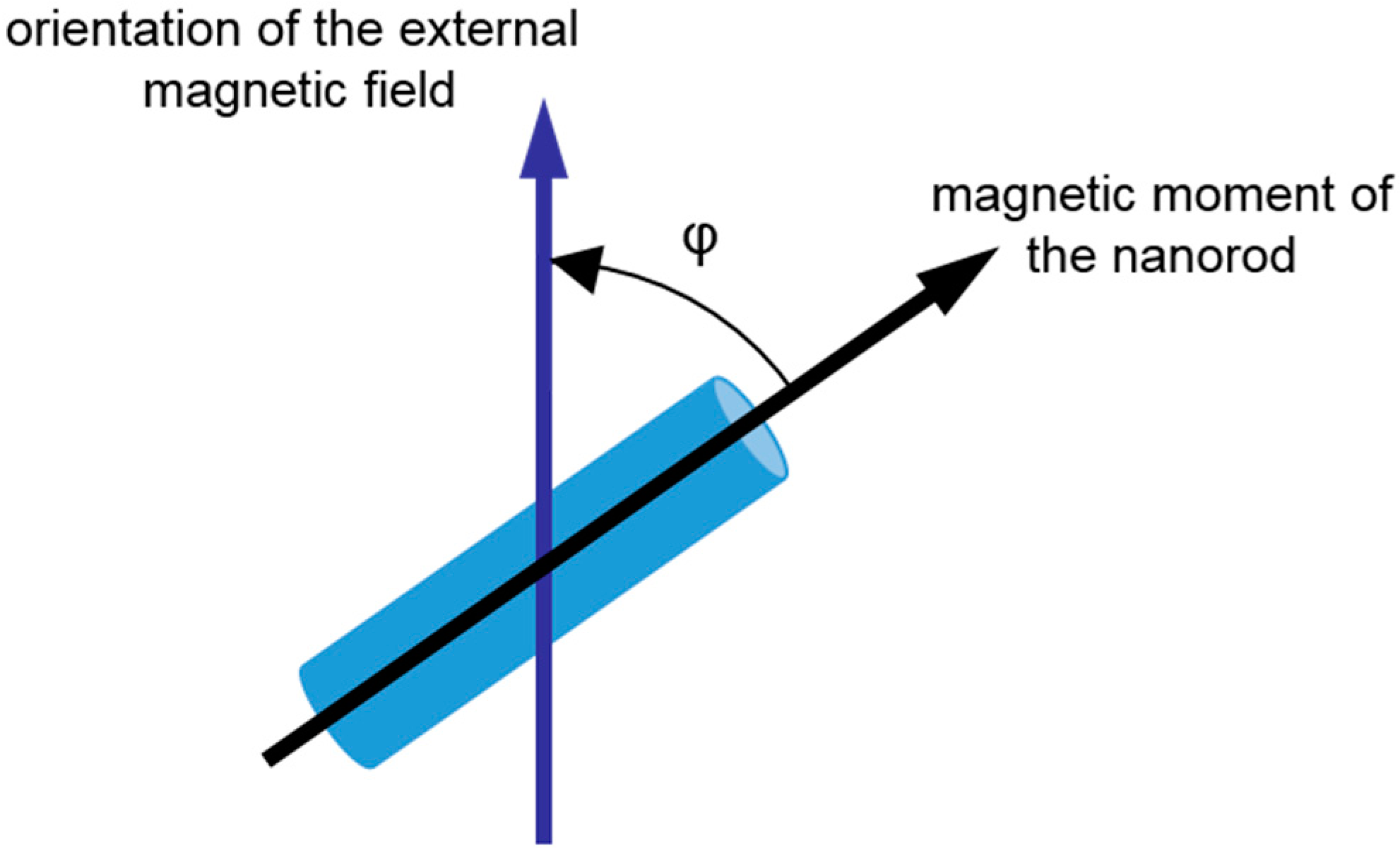
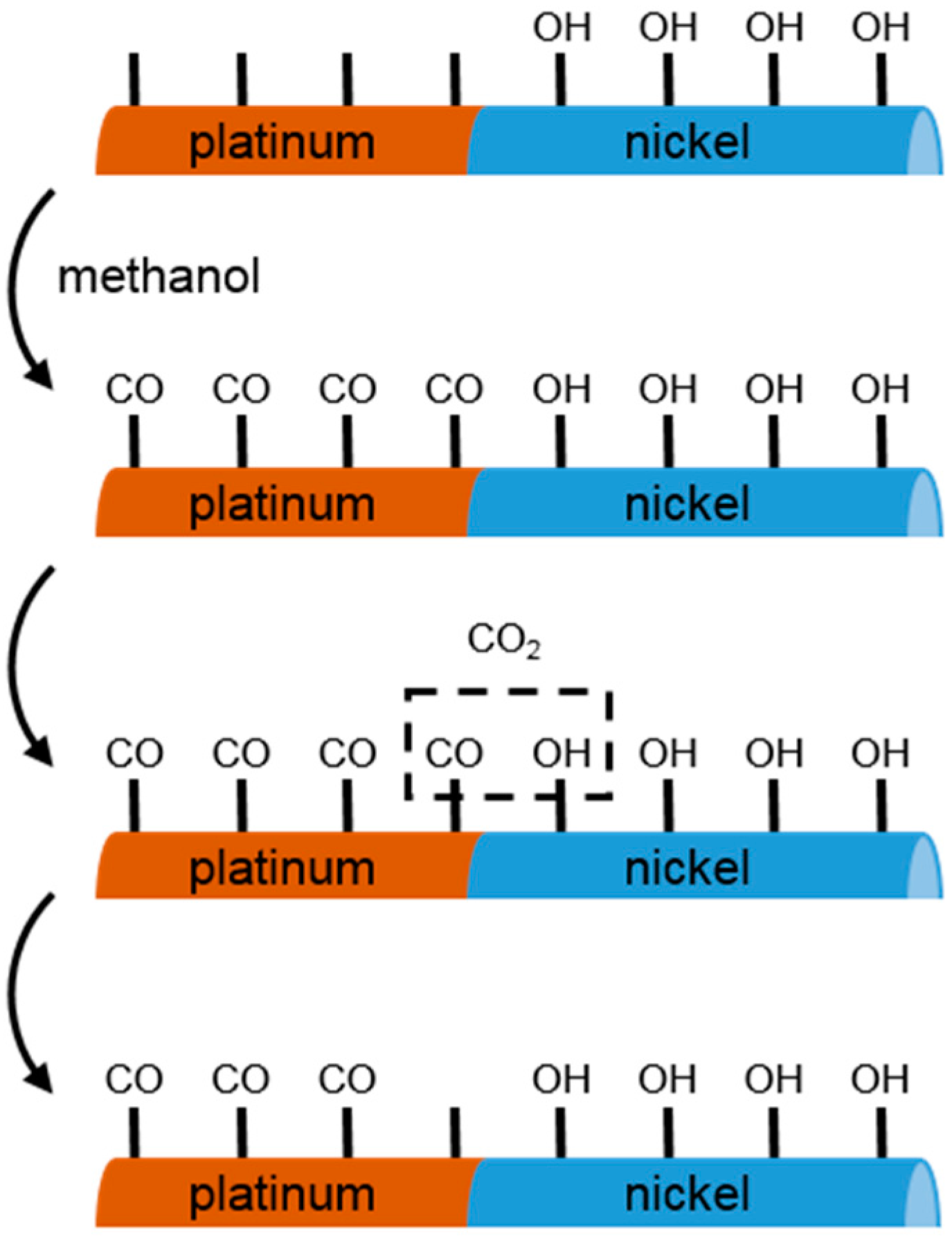

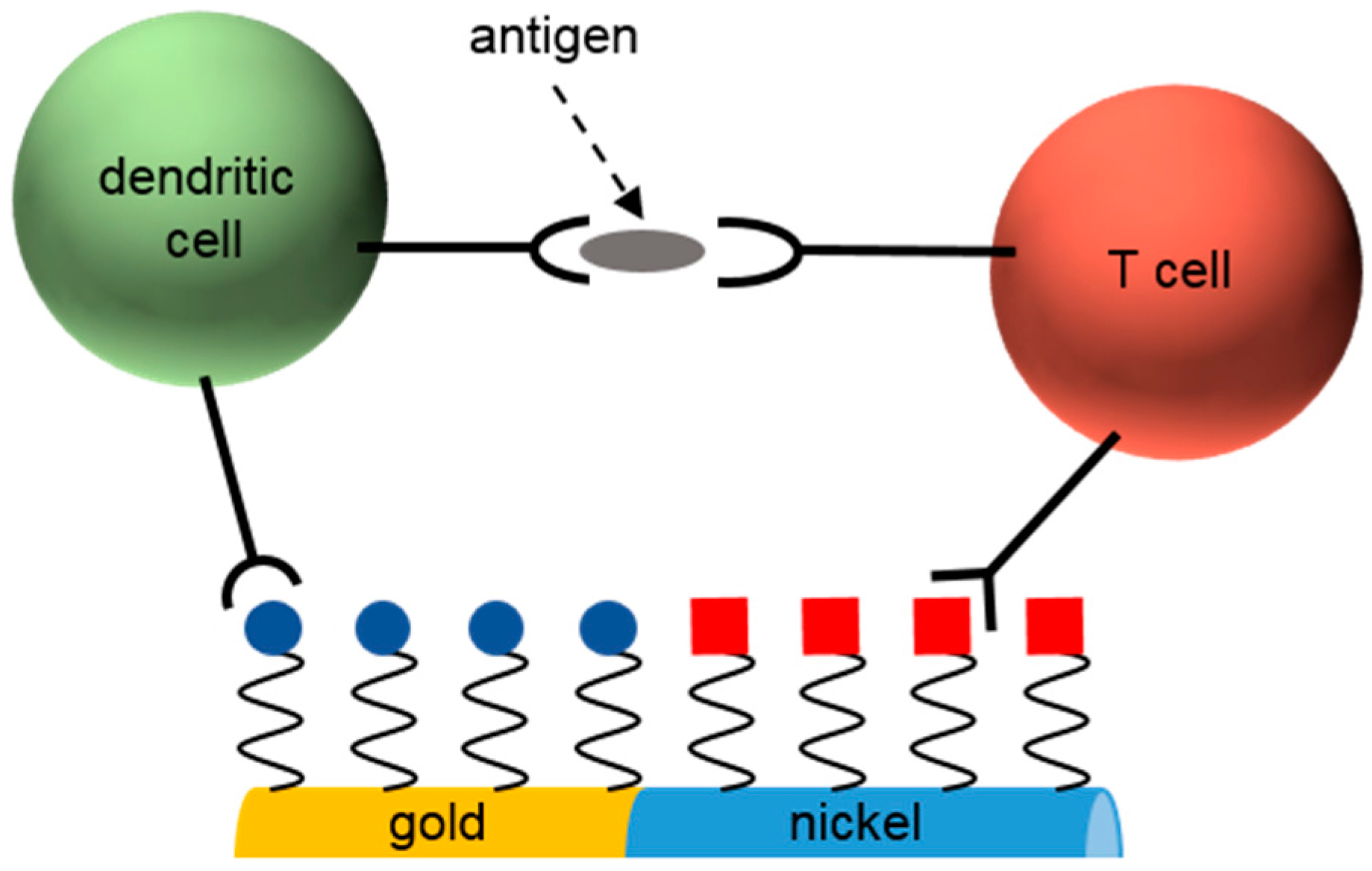
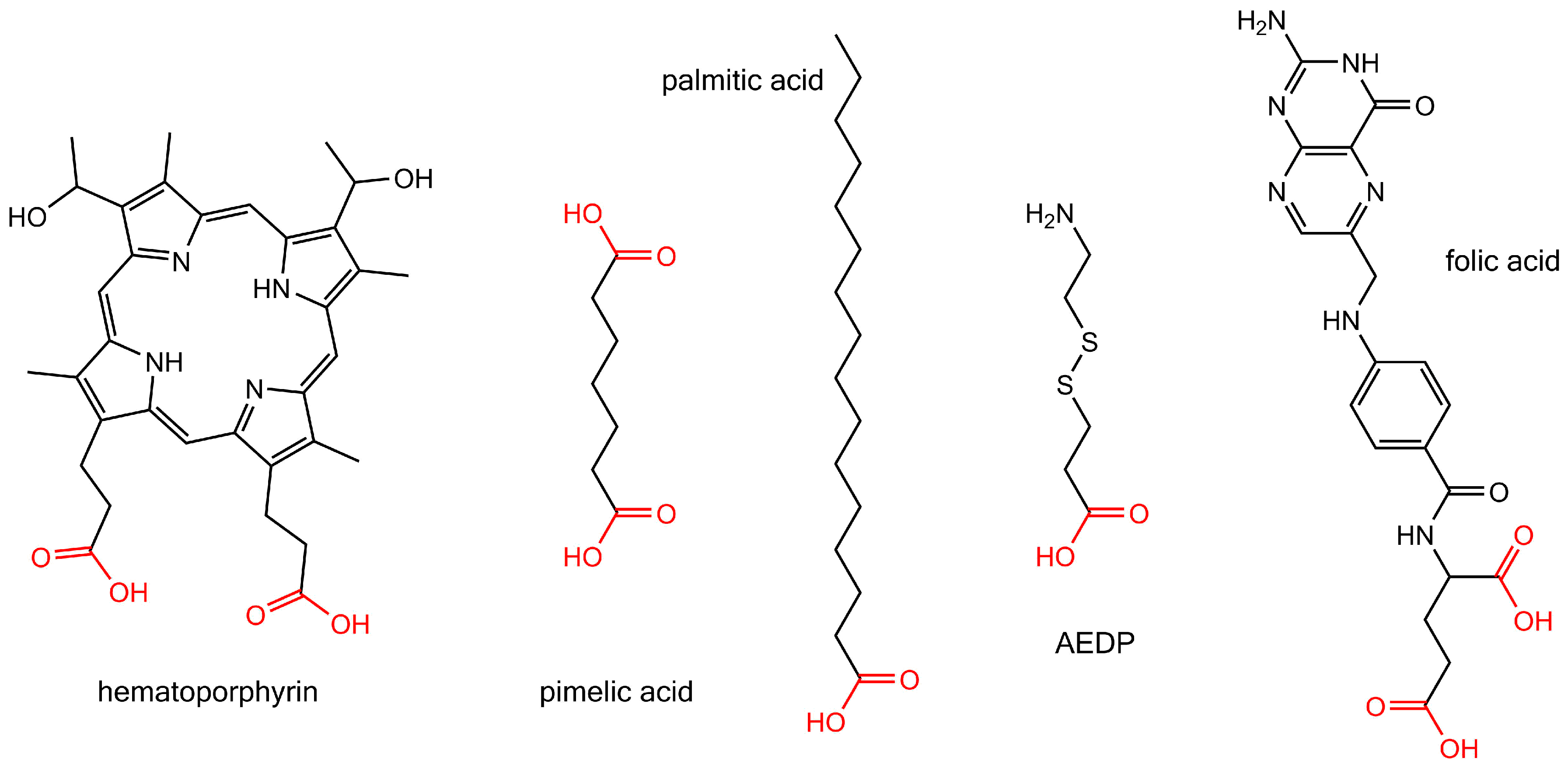
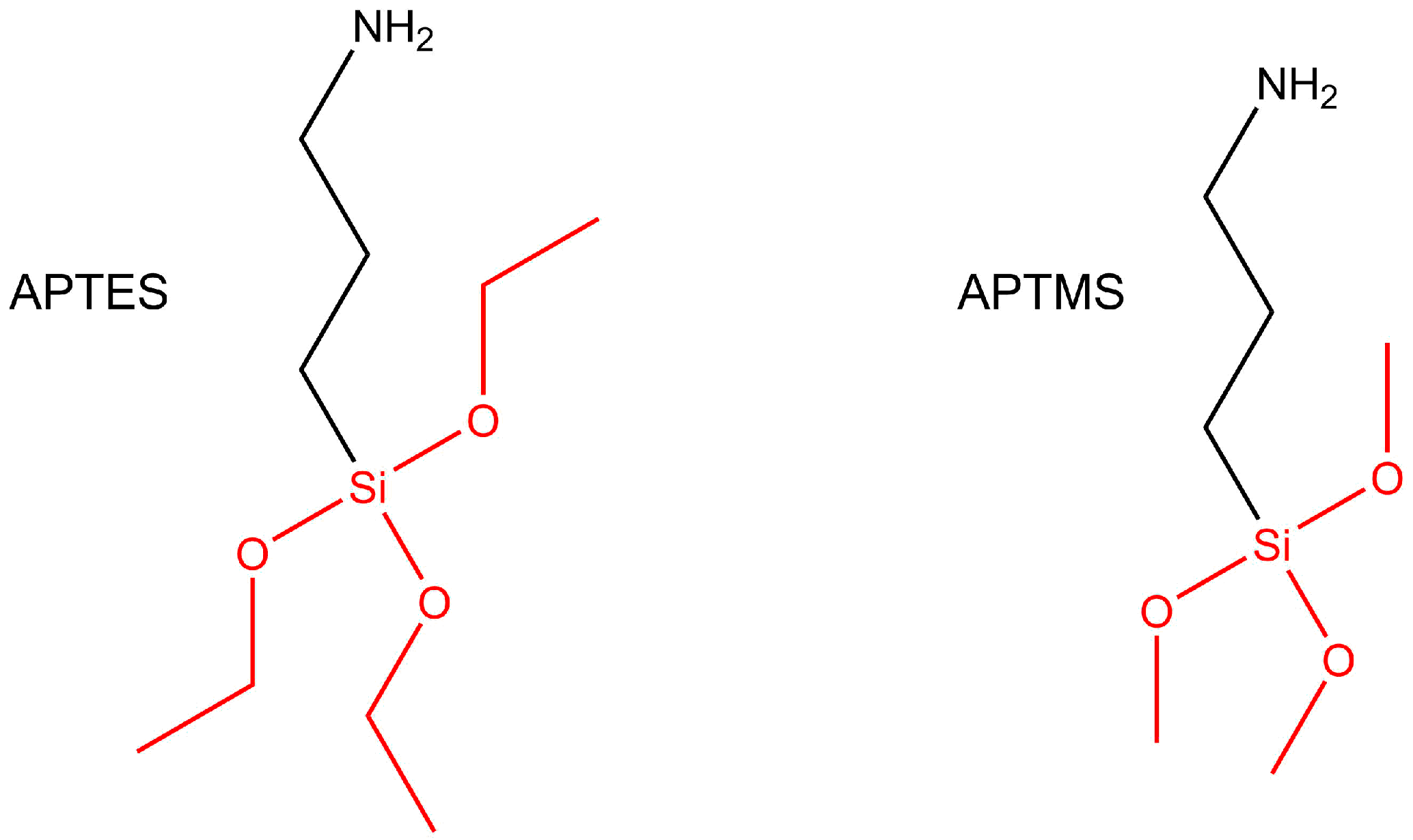
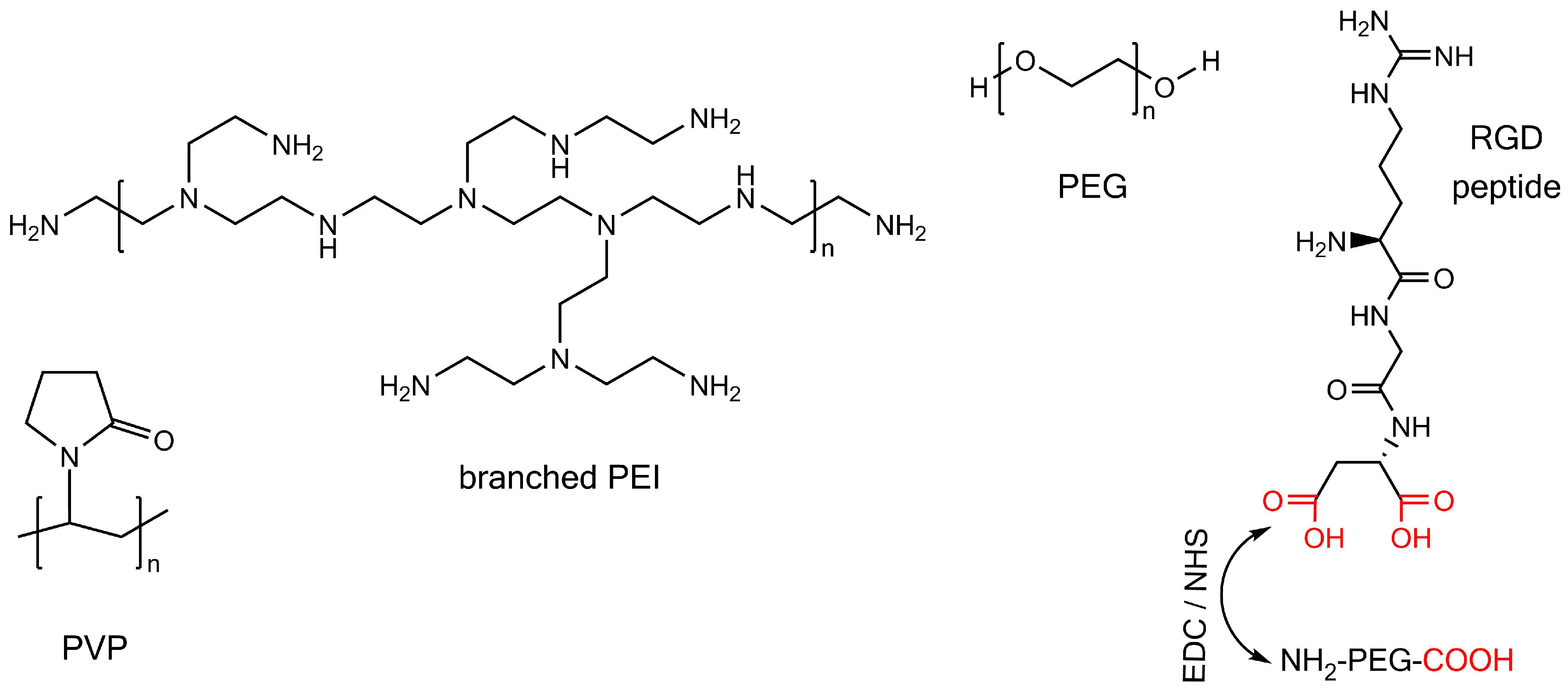
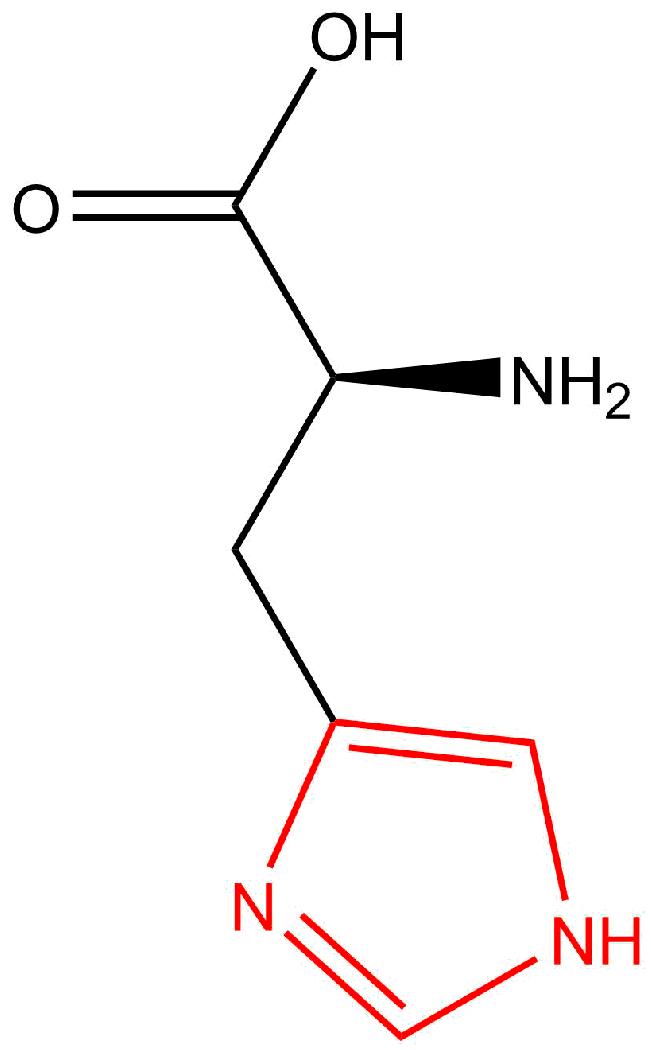

| Field of Application | Comments | References |
|---|---|---|
| Rheological fluid properties | Hydrogels | [89,90,91,92,93] |
| Micellar solutions | [94,95] | |
| Interfacial shear rheology | [96,97] | |
| Data storage | Multilayered Ni-Cu nanorods | [98] |
| Electronics | Microwave electronics | [99,100,101,102,103,104] |
| Catalysis | Catalysis of methanol | [51,105] |
| Oxygen reduction | [106] | |
| Optical phenomena | Localized surface plasmon resonance | [107,108,109] |
| Surface-enhanced Raman scattering | [110,111,112] | |
| Liquid crystal technology | [113,114] | |
| Sensing and biosensing | Carbohydrates | [115,116,117,118,119,120] |
| Proteins | [121] | |
| Magnetic resonance imaging | [122] | |
| Heavy metal ions | [123] | |
| Cell biology | Internalized nanorods with external agitation | [124,125,126] |
| Release/presentation of target molecules | [127,128,129,130,131,132] | |
| Cell guidance/cell growth guidance | [133,134,135,136] | |
| Cell separation | [137,138,139,140] | |
| Inducing cell death | [141,142,143,144] |
| Surface Modification | Molecule/Shell Material | References |
|---|---|---|
| Small molecules based on carboxylic acid groups | Hematoporphyrin | [160,161] |
| Pimelic acid | [140] | |
| Palmitic acid | [162] | |
| AEDP 1 | [128] | |
| Folic acid | [130] | |
| Small molecules based on silane groups | APTES 2 | [163] |
| APTMS 3 | [164] | |
| Polymers | PVP 4 | [64,165] |
| Branched PEI 5 | [166] | |
| PEG 6 | [167] | |
| RGD peptide 7 | [132] | |
| Histidine | Histidine | [129,168] |
| Metal/metal oxide shell growth | Gold | [156,169,170] |
| Silica | [123,171] |
© 2017 by the authors. Licensee MDPI, Basel, Switzerland. This article is an open access article distributed under the terms and conditions of the Creative Commons Attribution (CC BY) license (http://creativecommons.org/licenses/by/4.0/).
Share and Cite
Schrittwieser, S.; Reichinger, D.; Schotter, J. Applications, Surface Modification and Functionalization of Nickel Nanorods. Materials 2018, 11, 45. https://doi.org/10.3390/ma11010045
Schrittwieser S, Reichinger D, Schotter J. Applications, Surface Modification and Functionalization of Nickel Nanorods. Materials. 2018; 11(1):45. https://doi.org/10.3390/ma11010045
Chicago/Turabian StyleSchrittwieser, Stefan, Daniela Reichinger, and Joerg Schotter. 2018. "Applications, Surface Modification and Functionalization of Nickel Nanorods" Materials 11, no. 1: 45. https://doi.org/10.3390/ma11010045
APA StyleSchrittwieser, S., Reichinger, D., & Schotter, J. (2018). Applications, Surface Modification and Functionalization of Nickel Nanorods. Materials, 11(1), 45. https://doi.org/10.3390/ma11010045





